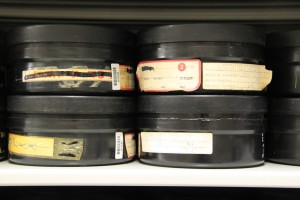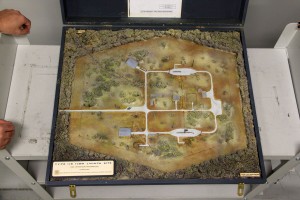December 10, 2010
Mark Stout, SPY Historian
Alexenia Dimitrova is one of the leading investigative journalists in Bulgaria, where she works for the second largest daily newspaper, 24 Hours. She has made a specialty of reporting on Bulgaria’s Communist-era intelligence services. She was kind enough to answer a few questions from the International Spy Museum.
Ms. Dimitrova, your latest book is entitled Murder Bureau. It’s about some of the brutalities of the Communist Bulgarian security service, the DS, during the Cold War. Can you tell us a bit about the DS and its notorious “Service 7”?
First, let me say that Service 7 was not notorious until July 2010 when I published Murder Bureau. The news and the documentary proof of this super-secret department were a surprise not only for my readers but also for me.
I have been digging into Bulgarian Secret Archives since 1990, immediately after the fall of Todor Zhivkov [the last Bulgarian Communist leader], but only twice in these years had I encountered hints—mostly rumors—that a separate unit responsible for so called “sharp measures” had existed in the Bulgarian State Security.
The first hint appeared back in early 90s. At that time I read a publication which alleged the existence of such a special unit within the First Main Directorate of the State Security—the Intelligence Directorate. Unfortunately, at that time the intelligence archives were not open to the public, so I was not able to look for proof.
Years later, in 1999, I read an interview with a former director of the Bulgarian Intelligence before 1989 Gen. Vlado Todorov. In the interview he claimed that there were only three cases of treason among the Bulgarian intelligence officers. One of the names he mentioned was Trayco Belopopsky. I sent a written request for all documents related to Belopopsky from the archive of the Ministry of Interior, which is separate from the Intelligence Archive.
When I got the documents I read that in 1964 Belopopsky was sentenced to death. I also read that he was born in 1935. My presumption was that the sentence was not carried out because he was out of the country and was sentenced in absentia. This gave me hope that he might be found alive somewhere around the world. I started searching for him in UK and in the USA, and months later I found him in New York.
He did not want to talk publicly but we had a long private correspondence. In May 2006 he shared the following:
“There was a secret Department of Wet Affairs (mokridela) [a Communist intelligence term referring to assassination]. The first head of the Department was the director of Sofia prison. His inmates became his staff, hardened criminals. They were sent abroad to do the killings and kidnappings, both for the Russians and the Bulgarians. Zhivkov had to have a former officer killed in Spain because the man had documents proving that Zhivkov was an agent of the tsarist secret police.I was still a student at Cambridge and they brought my father, hoping he will persuade me to return. They provided him with a present for me, when that failed, several “lukanka” [Bulgarian sausages]. When a piece of lukanka was given to a stray dog, it died within minutes in terrible agony. That was what gift they wanted the father to give his son. This is just one of many incidents. No matter what they say now, there are still people who want my head. They lost their good jobs and their careers were in ruin.”
This e-mail affected me and I asked myself – was this man right or he was paranoid?
I sent a written request to the Intelligence archive asking whether such a unit had existed. I got a negative response. Then, in 2006 a law for access to the secret documents from the communist era was passed. Shortly after that a small part of the inventories of the Bulgarian Intelligence Archives was publicly opened. I went and started reading them.
Honestly, I was not very confident that I would find such evidence because many documents had been destroyed. But I was lucky that the people who decided what to destroy had thought only about the recent past and not about earlier years. This way some documents had survived. I found some files left with abbreviations OM, SM, DM and AM in the titles. They meant Sharp and Special Measures, Disinformation and Active Measures… When I ordered and opened the files, I was shocked. There I found for first time real proof of the existence and the activities of a special unit carrying out such activities called Service 7. This name was not public until then.
Is there one particular victim of Service 7 who stands out in your mind?
All the cases are very interesting – 10 Bulgarian emigrants in 9 countries: German France, Italy, Sweden, Switzerland, Turkey, the UK, Denmark, and Ethiopia. They were targeted by Service 7 to be poisoned, kidnapped, discredited killed (which in the documents is mentioned as “clearance” or “liquidation”). Later I found some of these people or their relatives and interviewed them. This gave me additional information beyond what I found in the documents.
And by the way it really turned out that Belopopsky had been one of the targets of the secret unit. Unfortunately he did not live to see the documents which supported his suspicions. He died in early 2008.
In the International Spy Museum we have an example of the kind of poison-tipped umbrella that was used to kill Georgi Markov in London in 1978. Was Markov’ murder an operation by Service 7?
Markov was murdered long after the founding of Service 7 in 1963. The documents which I found are for the period 1963-1974. My presumption is that the Service continued operating after 1974, but most probably documents about later activities of Service 7 and its eventual successor and the preparation of the assassination of Markov have been destroyed.
Who chose the victims?
Good question. I still wonder who was the mastermind behind Service 7’s activities. Ambitious low-level officers from that unit who wanted to make advance their careers? Or high-level officials in the State Security? I found documents showing that high-level officials had sought help from the KGB and other communist services for Service 7’s activities but I did not find documents discussing who the victims should be. However keep in mind that more than 3,000 pages about the unit and its targets were destroyed.
What sort of response have you received from Bulgarians about this book and your previous exposés of the abuses of the Communist regime?
It depends of the category of the readers. Ordinary people have welcomed the exposing of the truth. I got tens of phone calls, e-mails and letters from people, who applauded me for being brave enough to publish these facts and the documents. I have also traveled around Bulgaria to discuss the book and I have felt the same attitude.
At the same time, people who were involved with the former State Security have tried to downplay the truth. In one such case, when the anchor of a TV show invited a former officer from the intelligence services to discuss the book with me, the officer refused saying that these were pure fantasies. Also in the very first day of the publication I got a threatening anonymous phone call in the office. I invited the caller to come to talk about it but he hung up the phone.
I also heard some comments that Service 7 was not a big deal because similar services have existed within the CIA and the Mossad too. I do not know if this is true or not. However this is not argument not to expose documents and evidences about their Bulgarian counterpart.
The veterans of DS have not been happy about my work for several years. They were not happy with my first 3 books: The Iron Fist (2005) which is available in English, The War of the Spies (2005) and The King’s Secret Files(2009). They think that exposing these secret documents, I have betrayed their work. This is not true of course.
I understand that you were also able to do useful research in the United States.
Yes. During my specializations in journalism at the World Press Institute in St. Paul, Minnesota (1996), the University of Columbia in Missouri (1998), and the University of Minnesota (2006), I learned that accessing and exposing documents under the American Freedom of Information Act is one of the strongest weapons of the journalist. So in 1998 I started requesting documents about Bulgaria during the Cold War from American government agencies. One of the reasons for this was that many of the documents in Bulgaria had been destroyed and the US was the only place where we could read some truths about our country.
Are there plans to publish Murder Bureau in English?
I would be more than happy to do this. I want to expose this truth for as large an international public as possible. This way the people in Bulgaria who are trying to underestimate the truth and are saying that the documents are pure fantasy, will have no more ground to do this.
However I am realistic that Bulgaria by itself could not attract a large international attention. I think that an international investigation about similar units in the former Soviet satellite countries, the Soviet Union, or even in some Western countries, could be more attractive for the international reader.
After the publication of Murder BureauI also was told about a Stasi assassination unit in East Germany and a book published about it by Thomas Auerbach.
My work and other work like mine could be included in an eventual international documentary research project on the issue. I would be happy to contribute for the Bulgarian part.
If you read Bulgarian and wish to purchase a copy of Murder Bureau, please contact Alexenia Dimitrova at alexenia@gmail.com.










